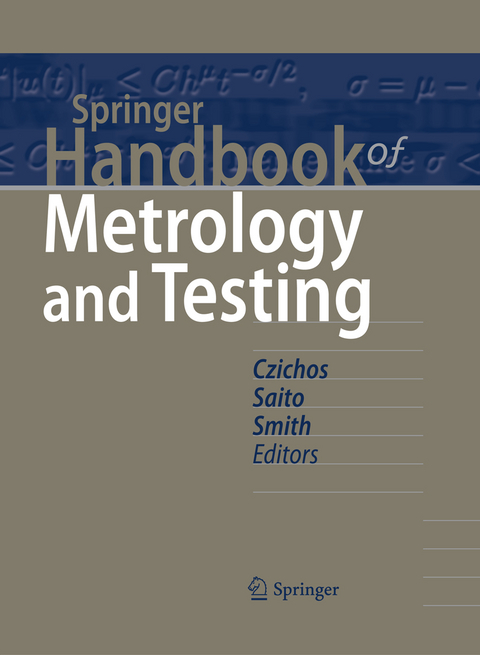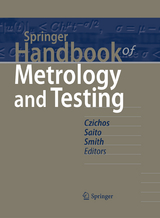Springer Handbook of Metrology and Testing
Springer Berlin (Verlag)
978-3-642-16640-2 (ISBN)
This Springer Handbook of Metrology and Testing presents the principles of Metrology - the science of measurement - and the methods and techniques of Testing - determining the characteristics of a given product - as they apply to chemical and microstructural analysis, and to the measurement and testing of materials properties and performance, including modelling and simulation.
The principal motivation for this Handbook stems from the increasing demands of technology for measurement results that can be used globally. Measurements within a local laboratory or manufacturing facility must be able to be reproduced accurately anywhere in the world.
The book integrates knowledge from basic sciences and engineering disciplines, compiled by experts from internationally known metrology and testing institutions, and academe, as well as from industry, and conformity-assessment and accreditation bodies.
The Commission of the European Union has expressed this as there is no science without measurements, no quality without testing, and no global markets without standards.
Prof. Dr. Dr. Horst Czichos war über zehn Jahre lang Präsident der Bundesanstalt für Materialforschung und -prüfung (BAM) in Berlin, die die Bundesregierung in Fragen der Materialtechnik und Chemie berät. Er lehrt Mechatronik an der Beuth-Hochschule für Technik Berlin und ist Träger des Christian-Peter-Beuth-Preises für herausragende Leistungen zur Förderung der Ingenieurausbildung.
lt;p>The Springer Handbook of Metrology and Testing is a comprehensive treatise of Metrology, the science of measurement, and of Testing, the technical procedure of determining characteristics of a given object, product or process. The Handbook is organized in five parts.
Part A: Fundamentals of Metrology and Testing
Part A describes the basic elements of metrology, the system which allows measurements made in different laboratories to be confidently compared worldwide. The process of making reliable measurements is analyzed along with quality issues of the measurement and testing procedures.
Chap. 1 Introduction to Metrology and Testing
Chap. 2 Metrology Principles and Organization
Chap. 3 Quality in Measurement and Testing
Part B: Chemical and Microstructural Analysis
Part B presents methods for the analysis of material composition and structure. Structure here includes both atomic and molecular arrangements and also microstructure and defect structures over larger scales.
Chap. 4 Analytical Chemistry
Chap. 5 Nanoscopic Architecture and Microstructure
Chap. 6 Surface and Interface Characterization
Part C: Materials Properties Measurement
Part C evaluates the methods of measuring the fundamental properties of materials. In addition to all aspects of mechanical properties, the methods of characterizing the thermal, electrical, magnetic and optical properties of materials important to their practical applications are described.
Chap. 7 Mechanical Properties
Chap. 8 Thermal Properties
Chap. 9 Electrical Properties
Chap. 10 Magnetic Properties
Chap. 11 Optical Properties
Part D: Materials Performance Testing
Part D cores the testing of material performance in application conditions. This includes measurement of corrosion, friction and wear as well as biogenic impact on materials and more specific materials environment interactions. Evaluation of material performance and condition monitoring by nondestructive techniques and embedded sensors is also considered. Finally, experimental, deterministic and probabilistic methods for the characterization of safety and reliability are outlined.
Chap. 12 Corrosion
Chap. 13 Friction and Wear
Chap. 14 Biogenic Impact
Chap. 15 Environmental Interactions
Chap. 16 Nondestructive Testing and Reliability Evaluation
Part E: Modeling and Simulation Methods
Part E presents important modeling and simulation methods that underline measurement procedures that rely on mathematical models to interpret complex experiments or to estimate properties that cannot be measured directly.
Chap. 17 Molecular Dynamics Simulation
Chap. 18 Continuum Constitutive Modeling
Chap. 19 Finite Element and Finite Difference Methods
Chap. 20 The CALPHAD Method
Chap. 21 Phase Field Approach
Chap. 22 Monte Carlo Simulation
About the Authors.- Subject Index
| Erscheint lt. Verlag | 22.7.2011 |
|---|---|
| Reihe/Serie | Springer Handbooks |
| Zusatzinfo | 1500 p. 500 illus. in color. |
| Verlagsort | Berlin |
| Sprache | englisch |
| Original-Titel | Springer Handbook of Materials Measurement Methods |
| Maße | 193 x 242 mm |
| Gewicht | 2595 g |
| Themenwelt | Technik ► Maschinenbau |
| Schlagworte | Materials Measurement • Micorstructural Analysis • Molecular Modelling • Quality Control, Reliability, Safety and Risk • Standardization • Validation |
| ISBN-10 | 3-642-16640-7 / 3642166407 |
| ISBN-13 | 978-3-642-16640-2 / 9783642166402 |
| Zustand | Neuware |
| Haben Sie eine Frage zum Produkt? |
aus dem Bereich




